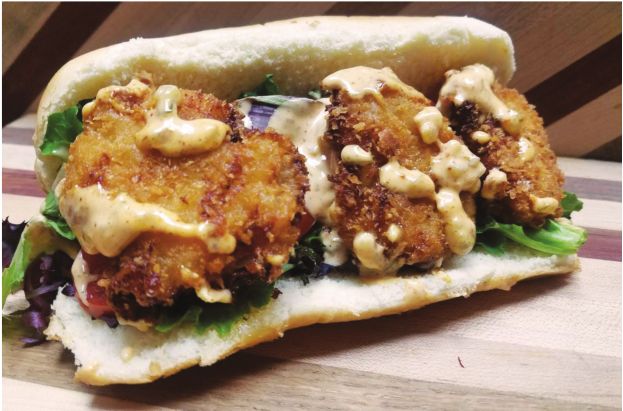
They say that when life gives you lemons, you should make lemonade. Likewise, when invasive fish take over the waterways in more than half of U.S. states, threatening the native ecologies and viability of fishing commerce from the Gulf Coast to the Great Lakes, chefs, fishermen and environmentalists say, “It’s time for a fish fry.”
Asian Carp, a prized source of protein in Asia for thousands of years, were first introduced to the Southern United States in the 1960s and 70s to help clean up aquaculture and waste treatment ponds. Asian Carp – not to be confused with the bottom-feeding common carp that have populated Midwestern ponds for centuries – feed primarily on plankton. During the 1970s and 90s, flooding caused Asian Carp to escape from ponds into the Mississippi River. The population eventually spread into the Illinois and Missouri River systems, now posing an imminent threat to the Great Lakes’ ecology and fishing industry.
Asian Carp have a voracious appetite for plankton and can grow to be 20, 50 or even 100 pounds. They quickly overcome native species and threaten populations of mussels, fish and other aquatic invertebrates. Astonishingly, Asian Carp now make up 70 percent of the Illinois River’s biomass.
Millions of dollars have been – and continue to be – spent on governmental efforts to reduce Asian Carp populations and restrict their movements. A recent plan released by the Army Corps of Engineers comes with an estimated price tag of $245 million, a $10 million annual operating budget and a proposal to equip a Joliet-area lock with electric barriers, underwater noise makers and water jets. Fortunately, there is a less costly, more sustainable and more effective strategy to address this impending crisis: if you can’t beat ’em, eat ’em!
Last week, guests at a luncheon at the University of Illinois were treated to a delicious meal featuring “Silverfin” (aka Asian Carp) cakes topped with sauce remoulade and a smoked Silverfin crouton, followed by a potatowrapped Silverfin fillet with creamed leeks and a tomato emulsion. Prized as a delicacy in Asia for years, Silverfin was virtually unknown in this country’s cuisine, but that is changing. The fish, while bony, is flaky and pearly white, with a clean, mild flavor, said Dr. Dawn Aubrey, the university’s associate director of dining and host of last week’s luncheon, which celebrated the collaborative efforts of officials from the U of I, the Illinois Department of Natural Resources and the Louisiana Department of Wildlife and Fisheries.
The Urbana-Champaign campus began serving Silverfin to
students almost three years ago, a move driven by the University’s focus
on sustainability. Aubrey began working with Clint Carter, co-owner of
Carter’s Seafood in Springfield, to source Silverfin and include it as
an option in some of the 40,000 meals served daily to students. This
fish is often served whole, either steamed or fried on a bed of greens
drizzled with Srirchia mayo. The UIUC chefs make a smoked Silverfin dip
that Aubrey says is “simply out of this world.” Silverfin is a popular
menu item, particularly with the university’s large Asian student
population, who grew up eating it, and among students wanting to make
food choices that positively impact the environment.
Carter,
a commercial fisherman, was recruited by Philippe Parloa, a Louisiana
chef with a passion for turning lemons into lemonade. He founded The
Silverfin Group Inc., to promote the commercial harvest of Asian Carp as
a viable and cost-effective alternative to threatened species of wild
fish and environmentally damaging farmed fish operations, as well as to
counteract food insecurity. Now, the Silverfin Group has teamed up with
Sysco Food Service to distribute the product nationally. This new
national distribution channel is an exciting development for folks like
Carter and Parola, who have been working for years to get these fish out
of the river and onto our dinner plates.
“Folks
around here don’t like the idea of fish with bones in it. Silverfin is a
bony fish, but the taste is delicious and very similar to crab or
shrimp because of their plankton-based diet,” Carter told me. Making the
best of a bony situation, Chef Parola’s “lemonade” has taken the form
of a crispy panko crusted Silverfin cake.
“We’ve
spent years promoting Silverfin,” said Chef Parola. “Now we all need to
work together to create a demand for these fish. Down south we don’t
have the luxury of putting up electric fences. The fish are here now and
they threaten the commercial and recreational fishing industry in the
Gulf States and the entire Mississippi River Basin. We need to create a
lasting bounty for these fish if we are to have any hope of protecting
the Great Lakes from similar devastation. The solution to this problem
is practical and transparent, it creates jobs and stimulates local
economies from the Gulf all the way up to Illinois. Everybody wins!” I
first tried Silverfin last week at Cooper’s Alleyside Bistro. Owners and
Chefs Justin and Kendra Cooper had been serving delicious locally
sourced food out of their StrEATside Bistro Food Truck for a couple of
years, appearing regularly at the Old State Capitol Farmers Market
before opening the Bistro inside Kingpin Lanes on North Dirksen last
year. There I was treated to a Silverfin Po Boy served on a roll with
mixed greens and remoulade sauce. The cakes were delightfully crispy,
with a flavor akin to a good crab cake.
Silverfin
cakes are also on the menu at Westwoods Lodge Pub and Grill on West
Jefferson in Springfield and Jalyrih Grill, a Decatur soul food
restaurant. They can be purchased hot and crispy with spicy Boom Boom
sauce from Carter’s Fish Market on South Grand, or frozen from Carter’s
or Robert’s Seafood on West Jefferson to take home and cook yourself.
Contact Ashley Meyer at [email protected].